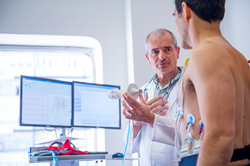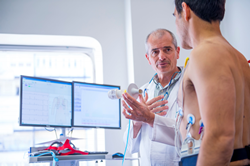
By 2027, experts predict a 27.6% increase in the total number of ASCs; more than 50% of all procedures performed there will treat cardiovascular issues.
Given [the] increase in cardiac procedures at ASCs, it follows [they] would enormously benefit from a unified, structured-reporting CVIS platform that [has] the same functionalities as those in major medical centers and are tailored-made for the needs and capabilities of the ambulatory center.
BOSTON (PRWEB)
April 18, 2022
For more than four decades, ambulatory surgery centers (ASCs) have offered patients the convenience of having certain surgical procedures performed outside the hospital setting.(1) By 2027, experts predict a 27.6% increase in the total number of ASCs; more than 50% of all procedures performed there will treat cardiovascular issues.(2) To handle increasing patient loads, cardiologists in these centers will need access to technology providing comprehensive data management throughout the entire care cycle. Dr. Serge Makowski, CEO and Co-founder of leading software design firm MediReport, says, “Moving certain cardiac procedures to an ASC provides many benefits. The patient receives the convenience and affordability of ambulatory care. The physicians benefit from more convenient scheduling and more autonomy. And the insurance companies benefit as ASCs offer the same procedures as hospitals but at a rate that is 35 to 50 percent less costly.”
According to some estimates, there are now more than 9,000 ASCs in the United States,(3) and single-specialty cardiology ASCs are rapidly growing in number. In 2019, the Centers for Medicare and Medicaid Services (CMS) updated their definition of surgery to include “surgery-like” procedures. This resulted in an expansion of their reimbursement list to include more than 18 cardiac catheterization-related procedures such as heart catheterizations, coronary interventions, and pacemaker implants.(4) CMS continues to approve more procedures for outpatient reimbursement, driving the need for unified cardiovascular information systems that provide end-to-end data management.
How ASCs benefit patients, providers, and the healthcare system
ASCs offer the same surgical care services as many larger inpatient facilities at a fraction of the cost. Some estimates show that surgical procedures performed in an ASC may be 35 to 50% less expensive compared to the same procedure performed in a hospital.(5) In addition to these cost savings, greater emphasis on excellent customer service and a commitment to delivering the highest quality care helps improve patient outcomes and lowers the chance of complications, such as infection, after a procedure.(6)
Statistics show that approximately 90% of all ASCs are fully or partially owned by physicians.(6) Physicians benefit from a more convenient scheduling and flexibility in staff, equipment, and supplies and tend to get more autonomy and customized surgical environments in ASC settings.
For the healthcare system as a whole, ASCs provide the ability to move lower-risk, routine cardiovascular procedures out of the inpatient setting. This frees up valuable cardiac cath and electrophysiology lab time for patients suffering from complex medical issues or trauma.
Technology needs
Given this increase in cardiac procedures at ASCs, it follows that these centers would enormously benefit from a unified, structured-reporting CVIS platform that in addition to having the same functionalities as those in major medical centers are tailored-made for the needs and capabilities of the ambulatory center. ASCs currently have lighter patient loads and provide less medically complex procedures compared to hospitals. However, they also usually have less staff and a lighter information technology (IT) infrastructure. And since ASCs aren’t reimbursed at the same rate as larger facilities, it’s important to find technology solutions that don’t hurt the bottom line.
MediReport, a software company that understands the specificities of ASC settings, already provides a CVIS solution called CardioReport Ambulatory. Specifically tailored for ASC needs and requirements, the cloud-based system intelligently guides the clinician on the mandatory and important procedural data abiding by the latest clinical guidelines and generates near real-time reports which are automatically incorporated into the facility’s electronic medical record (EMR).
Based on 25-plus years of medical expertise, the system enables doctors to leverage extensive built-in clinical depth with functionalities such as structured reporting (with templates customized to the physician’s and practice’s specific workflows), inventory management, score calculation (SCAI, SYNTAX), analytics dashboards and post discharge follow ups. The same data may be repurposed repeatedly for clinical research or registry participation, without the need for repeated manual data entry. The end result is greater physician satisfaction as it dramatically improves not only their experience of performing and reporting on procedures, but it completely unifies their diagnostic reporting for accuracy. Functionalities include, but are not limited to:
- Automated scoring calculation (Syntax, STS, SCAI, and more).
- Automated generation of structured reporting featuring customizable templates in 15 different languages.
- Customizable research protocols and structured databases.
- Dynamic integration of the latest clinical guidelines.
- Supply management including device traceability, activity monitoring, consumption, and forecasting future needs.
- Scheduling and appointment setting.
- Pre-admission patient screening and post-procedure monitoring.
- Data analytics and registry participation.
As ASCs grow in number and offer more access to nonurgent surgical procedures, better data management systems are required to boost the patient care experience and help minimize costs, explains Dr. Makowski.
CardioReport Ambulatory offers a unified but flexible platform for the clinical team to perform their daily tasks in one single platform. In addition, as a cloud-based solution, it fills any potential information gaps that could arise throughout the care cycle by providing remote access to procedure reports or pertinent data from any device (computer, tablet, or smartphone), anywhere and at any time. Adopting a unified CVIS drastically reduces clinical team workload, improves clinical outcomes and results in greater physician satisfaction while reducing costs.
“It was paramount for us to adapt our product and related services to efficiently deliver the CVIS that ASCs value most. At MediReport we consider our customers as our partners, and we work with each of them to support their initiatives and offer customization per site. We bolster customer success by ensuring smooth implementation, easy clinical adoption, and expert technical support. We have built teams of clinical specialists, account managers and IT experts to support the user every step of the way. As we know price pressure is important on ASCs due to lower reimbursement, we have tailored our price point to meet their financial constraints based on patient volume and size of the facility. However, this is critical for us that lower cost does not imply lower quality or technology,” Dr. Makowski says.
About MediReport
MediReport, a global supplier of cloud-based software for medical applications, was founded in 1995 by cardiologists Dr. Serge Makowski and Dr. Fabrice Beverelli. Through its comprehensive CVIS, CardioReport™ Suite, MediReport provides vastly improved clinical workflows that save time, improve quality, and generate high revenue for client organizations. The company is committed to delivering quality products that address the evolving needs of cardiology and IT technologies, based on its foundational principles: clinical excellence, customer satisfaction, continuous improvement of its products and innovations, and commitment and responsiveness. They have equipped over 450 hospitals in more than 35 countries. For more information, visit medireport.net.
Sources
1. “Value-Based Care and Independent ASC Billing Facilities.” Leading Medical Billing Services – USA, 29 June 2021, medicalbillersandcoders.com/blog/value-based-care-and-independent-asc-facilities-what-you-should-know/.
2. Thompson D and Comeau C. “The Strategic Role of Ambulatory Surgery Centers Cardiology Care.” DAIC, 1 Oct. 2021, dicardiology.com/article/strategic-role-ambulatory-surgery-centers-cardiology-care.
3. “How Many Ambulatory Surgery Centers Are in the US?” Definitive Healthcare, definitivehc.com/blog/how-many-ascs-are-in-the-us#:
4. “Texas Cardiologist Discusses Procedures in the ASC Setting.” ASC Focus Magazine, ascfocus.org/ascfocus/content/articles-content/articles/2020/digital-debut/texas-cardiologist-discusses-procedures-in-the-asc-setting#:
5. Biesen, Tim van, and Todd Johnson. “Ambulatory Surgery Center Growth Accelerates: Is Medtech Ready?” Bain, 26 June 2020, hbain.com/insights/ambulatory-surgery-center-growth-accelerates-is-medtech-ready/.
6. “ASCS: A Positive Trend in Health Care.” ASCs: A Positive Trend in Health Care – Advancing Surgical Care, ascassociation.org/advancingsurgicalcare/aboutascs/industryoverview/apositivetrendinhealthcare.

